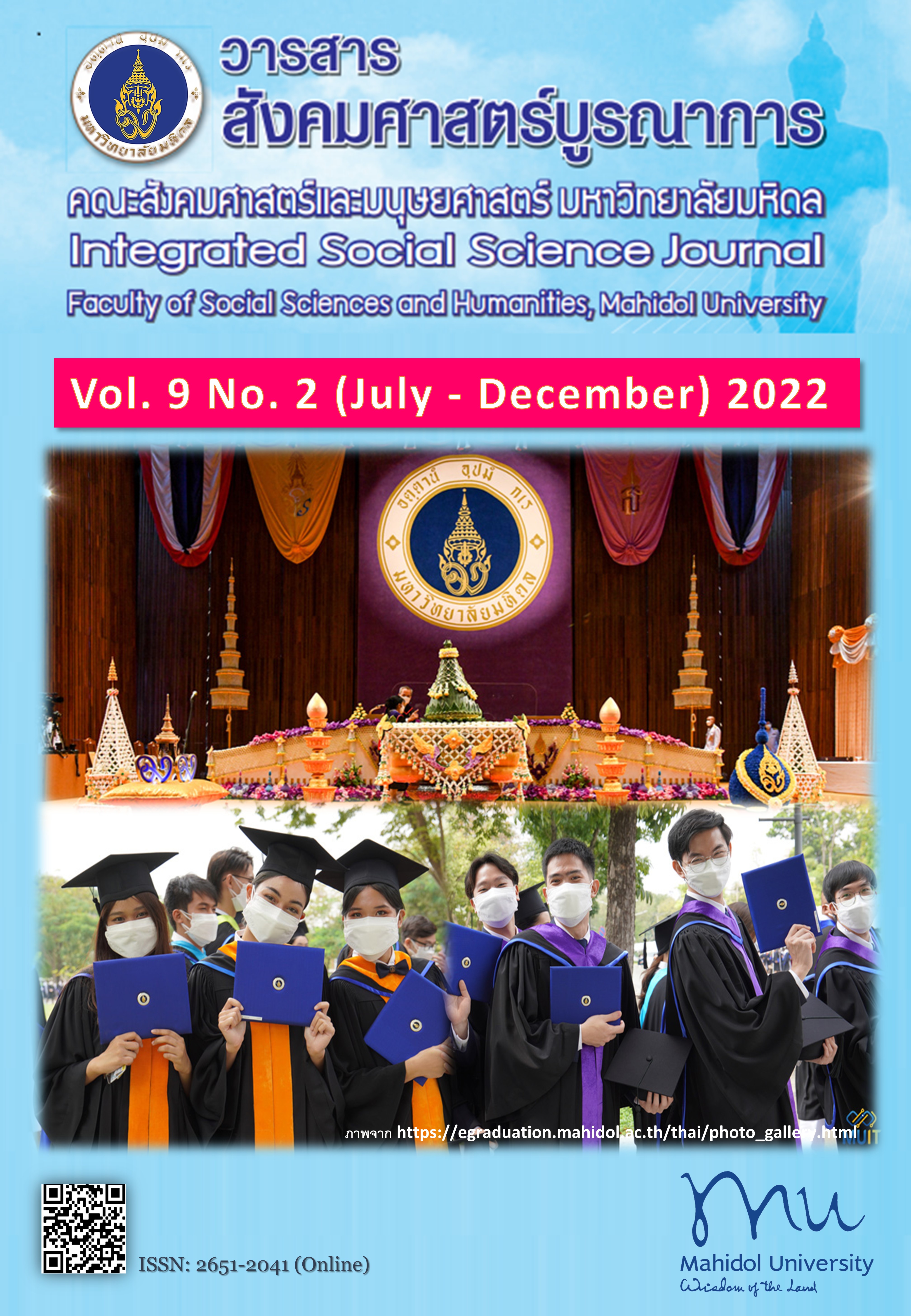แนวคิดสุขภาพและการแพทย์ทางเลือก: มุมมองจากผู้ใช้การแพทย์ทางเลือก
Main Article Content
บทคัดย่อ
การวิจัยนี้มีวัตถุประสงค์เพื่อศึกษาแนวคิดเรื่องสุขภาพ และประสบการณ์การใช้การแพทย์ทางเลือก จากมุมมองของผู้เลือกใช้การแพทย์ทางเลือก วิธีการศึกษาใช้วิธีการศึกษาเชิงคุณภาพ โดยการสัมภาษณ์เชิงลึกกับผู้ให้ข้อมูลจำนวน 10 ราย ที่มีลักษณะทางสังคม ประชากร อาชีพที่หลากหลาย โดยเลือกแบบเจาะจงกับผู้ให้ข้อมูลที่มีประสบการณ์การใช้การแพทย์ทางเลือกหลายรูปแบบ วิเคราะห์ข้อมูลโดยใช้การวิเคราะห์ข้อมูลเชิงเนื้อหา
ผลการศึกษาพบว่า ประชาชนมีมุมมองด้านสุขภาพในเชิงบูรณาการในทุกมิติ ทั้งการปราศจากโรค หรือความเจ็บป่วย การมีความแข็งแรง มีภูมิต้านทาน มีความสุข และการมีความสามารถในการดูแลตนเอง นิยามสุขภาพจึงไม่ได้มีความหมายที่คงที่ แต่ลื่นไหล เป็นพลวัตร ในขณะที่แนวคิดต่อการแพทย์ทางเลือก มีความหลากหลาย ทั้งการเป็นการแพทย์ที่ไม่ใช่การแพทย์กระแสหลัก การมีศักดิ์ศรีที่ด้อยกว่า การแพทย์แบบองค์รวม บูรณาการ เข้าถึงง่าย เป็นการแพทย์ที่ประชาชนตัดสินใจเลือก และผู้ใช้บริการต่อรองได้ ซึ่งข้อมูลเหล่านี้ สะท้อนแนวคิดเรื่องสุขภาพในยุคหลังสมัยใหม่ ที่มีชุดวาทกรรมที่หลากหลาย และอำนาจในตนในการมุ่งที่จะดูแลตนเอง
งานวิจัยนี้มีข้อเสนอแนะในการนำชุดวาทกรรมการแพทย์ทางเลือกที่เกี่ยวข้องกับอุดมการณ์การดูแลตนเอง การรับผิดชอบสุขภาพด้วยตนเอง เพื่อการขับเคลื่อน ส่งเสริม และผลักดันนโยบายการเสริมสร้างชุมชนเข้มแข็งในการดูแลตนเองด้านการแพทย์ทางเลือกอย่างเป็นรูปธรรม และเพิ่มช่องทางการให้ความรู้เกี่ยวกับการแพทย์ทางเลือกที่หลากหลาย และให้ประชาชนเป็นผู้ตัดสินใจเลือก สนับสนุนองค์กรประชาคมสุขภาพในระดับรากหญ้าในการจัดกระบวนการเรียนรู้ด้านการแพทย์ทางเลือก
Article Details

อนุญาตภายใต้เงื่อนไข Creative Commons Attribution-NonCommercial-NoDerivatives 4.0 International License.
- วารสารสังคมศาสตร์บูรณาการ มหาวิทยาลัยมหิดล อนุญาตให้สามารถนำไฟล์บทความไปใช้ประโยชน์และเผยแพร่ต่อได้ โดยอยู่ภายใต้เงื่อนไขสัญญาอนุญาต CC Attribution-NonCommercial-NoDerivatives 4.0 International (CC BY-NC-ND 4.0) โดยต้องแสดงที่มา/การอ้างอิงจากวารสาร – ไม่ใช้เพื่อการค้า – ห้ามแก้ไขดัดแปลงเนื้อหา
- ข้อความที่ปรากฏในบทความในวารสารฯ เป็นความคิดเห็นส่วนตัวของผู้เขียนแต่ละท่าน ไม่เกี่ยวข้องกับกองบรรณาธิการวารสารฯ (ซึ่งหมายรวมถึง บรรณาธิการ ผู้ทรงคุณวุฒิในกองบรรณาธิการ หรือ บรรณาธิการรับเชิญ) แต่อย่างใด ความรับผิดชอบองค์ประกอบทั้งหมดของบทความแต่ละเรื่องเป็นของผู้เขียนแต่ละท่าน หากมีความผิดพลาดใด ๆ ผู้เขียนแต่ละท่านจะรับผิดชอบบทความของตนเอง ตลอดจนความรับผิดชอบด้านเนื้อหาและการตรวจร่างบทความเป็นของผู้เขียน ไม่เกี่ยวข้องกับกองบรรณาธิการวารสารฯ
- กองบรรณาธิการขอสงวนสิทธิ์ในการตัดทอน/ปรับแก้ถ้อยคำบางประการเพื่อความเหมาะสม
เอกสารอ้างอิง
โกมาตร จึงเสถียรทรัพย์, เทพินทร์ พัชรานุรักษ์, และปารณัฐ สุขสุทธิ์. (บ.ก.). (2557). วัฒนธรรมสุขภาพในสังคมอาเซียน. สำนักวิจัยสังคมและสุขภาพ.
ตวงพร กตัญญุตานนท์. (2551). การแพทย์ทางเลือก (Alternative Medicine). วารสาร มฉก. วิชาการ, 11(22), 68-78.
ชาย โพธิสิตา. (2556). ศาสตร์และศิลป์การวิจัยเชิงคุณภาพ. อมรินทร์พริ้นติ้ง.
ประไพพิมพ์ สุธีวสินนนท์ และประสพชัย พสุนนท์. (2559). กลยุทธ์การเลือกตัวอย่างสำหรับการวิจัยเชิงคุณภาพ วารสารปาริชาต มหาวิทยาลัยทักษิณ, 29(2), 32-48.
ยาใจ พงษ์บริบูรณ์. (2553). การศึกษาแบบกรณีศึกษา (Case Study). วารสารศึกษาศาสตร์มหาวิทยาลัยขอนแก่น, 33(4), 42-50.
ศุภนิมิต ฑีฆชุณหเถียร. (2557). การแพทย์ทางเลือก (Alternative Medicine). วารสารเภสัชวิทยา, 26(1),41-52.
สำนักข่าว Hfocus. (2564). เจาะลึกระบบสุขภาพนโยบายการดำเนินงานกระทรวงสาธารณสุขปีงบประมาณ 2565 โดย นายอนุทิน ชาญวีรกูล. https://www.hfocus.org/content/2021/10/23483
Aakster, C. (1986). Concepts in alternative Medicine. Social Sciences and Medicine, 22, 265–273.
Bakx. (1991). The eclipse of folk medicine in Western society. Sociology of Health and Illness, 13(1), 20-38.
Chung, V. C. H., Hillier, S., Lau, C. H., Wong. S. Y. S., Yeoh, E. K., & Griffiths, S. M. (2011). Referral to and attitude towards traditional Chinese medicine amongst Western medical doctors in postcolonial Hong Kong. Social Sciences and Medicine, 72(2), 247–255. https://doi.org/10.1016/j.socscimed.2010.10.021
Collinge, W., Wentworth, R., & Sabo, S. (2005). Integrating complementary therapies into community mental health practice: An exploration. Journal of Alternative Complementary Medicine, 11(3), 569–574. https://doi.org/10.1089/acm.2005.11.569
Eastwood, H. (2000). The postmodern appeal of complementary and alternative medicines (CAM) to Australian consumers: A review of the literature. Sociological Sites/Sights, TASA 2000 Conference, Flinders University.
Eisenberg, D. M., Kessler, R. C., Foster, C., Norlock, F. E., Calkins, D. R., & Delbanco, T. L. (1993) Unconventional medicine in the United States. Prevalence, cost, and patterns of use. The New England Journal of Medicine, 328, 246-252. https://doi.org/10.1056/NEJM199301283280406
Ernst, E. (2000). Prevalence of use of complementary/alternative medicine: A systemic review. Bulletin of the World Health Organization, 78(2), 252-257.
Fairclough, N. (2010). Critical discourse analysis: The critical study of language. Routledge.
Fan, K. W. (2005). National Center for Complementary and Alternative Medicine website. Journal of Medical Library Associations, 93(3),410–412.
Furnham, A., & Forey, J. (1994). The attitudes, behaviors, and beliefs of patients of conventional vs complementary (Alternative) medicine. Journal of Clinical Psychology, 50(3), 458-469. https://doi.org/10.1002/1097-4679(199405)50:3<458::aid-jclp2270500318>3.0.co;2-v
Foucault, M., & Gordon, C. (1980). Power/knowledge: Selected interviews and other writings, 1972-1977. Pantheon Books.
Guh, J. Y., Chen, H. C., Tsai, J. F., & Chuang, L. Y. (2007). Herbal therapy is associated with the risk of CKD in adults not using analgesics in Taiwan. American Journal of Kidney Diseases, 49(5), 626–633.
Harris, P. E., Cooper, K. L., Relton, C., & Thomas, K. J. (2012). Prevalence of complementary and alternative medicine (CAM) use by the general population: A systematic review and update. International Journal Clinical Practices, 66(10), 924–39. https://doi.org/10.1111/j.1742-1241.2012.02945.x
Herzlich, C., & Pierre, J. (1987). Illness and self in society. John Hopkins University Press.
Hori, S., Mihaylov, I., Vasconcelos, J. C., & McCoubrie, M. (2008). Pattern of complementary and alternative medicine use amongst outpatients in Tokyo, Japan. BMC Complementary Alternative Medicine, 23, 8-14. https://doi.org/10.1186/1472-6882-8-14
Kanjanahattakij, N., Kwankhao, P., Vathesatogkit, P., Thongmung, N., Gleebbua, Y., Sritara, P., & Kitiyakara, C. (2019). Herbal or traditional medicine consumption in a Thai worker population: Pattern of use and therapeutic control in chronic diseases. BMC Complementary and Alternative Medicine, 19, 258. https://doi.org/10.1186/s12906-019-2652-z
Kleinman, A. (1980). Patients and healers in the context of culture: An exploration of the borderland between anthropology, medicine, and psychiatry. University of California Press.
Nastasi, B. K., & Schensul, S. L. (2005). Contributions of qualitative research to the validity of intervention research. Journal of School Psychology, 43(3), 177-195. https://doi.org/10.1016/j.jsp.2005.04.003
Putthapiban, P., Sukhumthammarat, W., & Sriphrapradang, C. (2017). Concealed use of herbal and dietary supplements among Thai patients with type 2 diabetes mellitus. Journal of Diabetes Metabolism Disorder, 16, 36. https://doi.org/10.1186/s40200-017-0317-3
Peltzer, K. Pengpid, S., Puckpinyo, A., Yi. S., & Vu, A L. (2016). The utilization of traditional, complementary and alternative medicine for non-communicable diseases and mental disorders in health care patients in Cambodia, Thailand and Vietnam. BMC Complementary Alternative Medicine, 16, 92. https://doi.org/10.1186/s12906-016-1078-0
Seo, H. J., Baek, S. M., Kim, S. G., Kim, T. H., & Choi, S. M. (2013). Prevalence of complementary prevalence of complementary and alternative medicine use in a community-based population in South Korea: A systematic review. Complementary Therapy Medincine, 21, 260-271. https://doi.org/10.1016/j.ctim.2013.03.001
Siahpush, M. (1998). Postmodern values, dissatisfaction with conventional medicine and popularity of alternative therapies. Journal of Sociology, 34, 58-70.
Siahpush, M. (1999). Postmodern attitudes about health: Population- based exploratory study. Complementary Therapy in Medicine, 7, 164-169. https://doi.org/10.1016/s0965-2299(99)80124-1
Siahpush, M. (2000). A critical review of the sociology of alternative medicine: Research on users, practitioners, and the orthodoxy. Health, 4(2), 159-178.
Stevenson, H. M., & Burke, M. (1992). Bureaucratic logic in new social movement clothing: The limits of health promotion research. Canadian Journal of Public Health, 83(1), S47-53.
Tangkiatkumjai, M., Boardman, H., Praditpornsilpa, K., & Walker, D. M. (2013). Prevalence of herbal and dietary supplement usage in Thai outpatients with chronic kidney disease: A cross-sectional survey. BMC Complementary Alternative Medicine, 13, 153. https://doi.org/10.1186/1472-6882-13-153
Tangkiatkumjai, M., Boardman, H., & Walker, D. M. (2014). Herbal and dietary supplement use in Bangkok: A survey. Journal of Complementary Integrative Medicine, 11, 203–211. https://doi.org/10.1515/jcim-2013-0016
Yu, C. (2021). Medical pluralism in a Dong Village, Southwestern China. International Journal of Anthropology and Ethnology, 5(2), 2-9. https://doi.org/10.1186/s41257-021-00042-9
Wode, K., Henriksson, R., Sharp, L., Stoltenberg, A., & Hök Nordberg, J. (2019). Cancer patients’ use of complementary and alternative medicine in Sweden: A cross sectional study. BMC Complementary and Alternative Medicine, 19(1), 1-11. https://doi.org/10.1186/s12906-019-2452-5
World Health Organization (WHO). (2013). WHO traditional medicine strategy: 2014-2023. World Health Organization.
Zhang, X. (1996). Traditional medicine and WHO. World Health, 2, 4-5.


